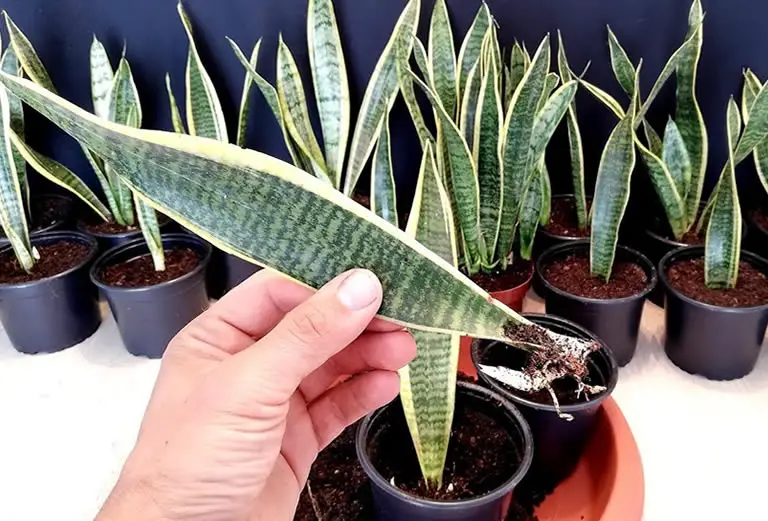If you love snake plants (Sansevieria, also called mother-in-law’s tongue), you’ll be happy to know that you can easily grow more without spending a dime! Instead of buying new plants, you can propagate the ones you already have using simple techniques.
It’s a fun and rewarding way to expand your indoor jungle—or even share new plants with friends!
Table of Contents
4 Easy Methods For Snake Plant Propagation
So, how do you propagate snake plants? There are four easy methods:




Once you have successful propagated a new plant be sure to follow our detailed instructions on snake plant care to ensure your plant grows healthy and quickly and lives for many years.
Excited to try it yourself?
Let’s dive into the details and figure out which propagation method is right for you!
How to Propagate Snake Plants in Water
One of the easiest ways to propagate a snake plant is by rooting cuttings in water.
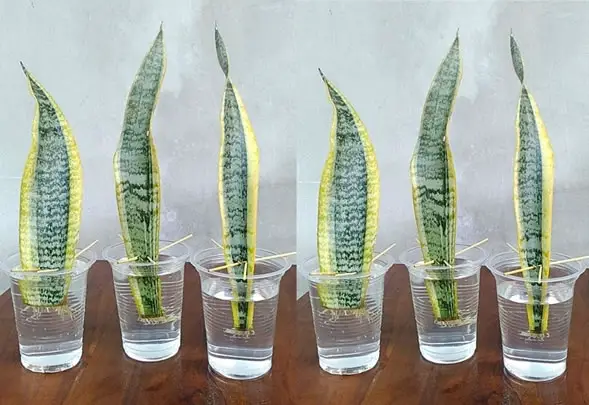
This method is perfect for rescuing bent or broken leaves, or for using up extra leaves you’ve pruned while shaping your plant.
Plus, it’s a fun and simple way to grow new plants!
What You’ll Need:




Step-by-Step Guide:







Although water propagation is super easy, it can take longer than other methods, especially if your plant doesn’t get much indirect light.
But with a little patience, you’ll have a brand-new snake plant ready to thrive in its new home!
How to Propagate Snake Plants in Soil
If you’re looking for a faster way to propagate snake plants, rooting cuttings in soil is a great option.
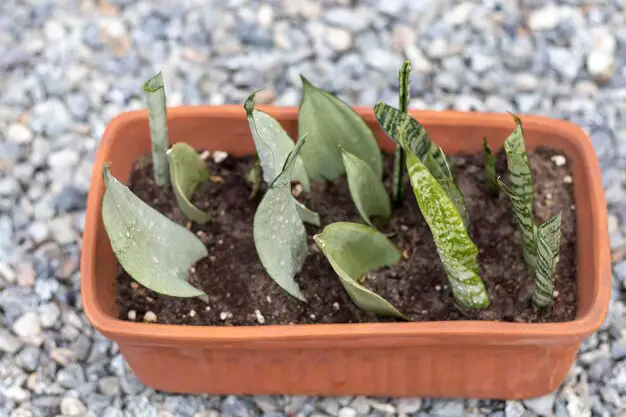
This method lets you get multiple new plants from just one leaf!
What You’ll Need:




Step-by-Step Guide:







Soil propagation is a bit faster than water propagation and is a great way to get multiple plants from one leaf. With a little patience, you’ll soon have plenty of new snake plants to add to your home or share with friends!
How to Propagate Snake Plants by Division
If you want more snake plants—fast, division is the way to go!
Instead of waiting for cuttings to root, this method lets you instantly create new plants by splitting up an existing one.
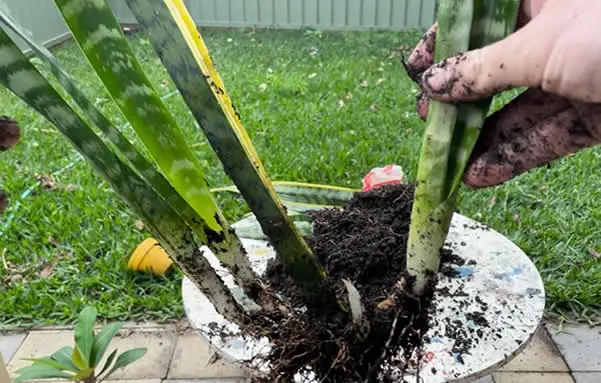
Another plant that is often propagated through plant division is the african violet.
However, snake plant division is very different to propagating african violets through division. So, if you are familiar with african violet division and want to propagate your snake plant in the same manner then you should still read this guide.
What You’ll Need:




Step-by-Step Guide:






That’s it! Division is the quickest way to grow your snake plant collection. Each section will continue growing as a separate, healthy plant, ready to thrive in your home!
Propagating Snake Plants Using Rhizomes
Did you know that snake plants grow from underground stems called rhizomes?
These horizontal stems store nutrients and produce new shoots, known as pups.
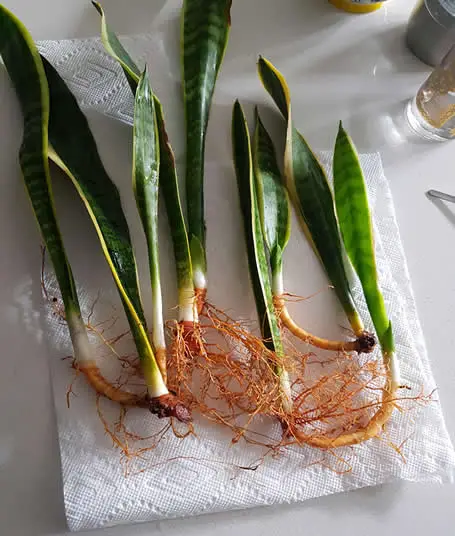
Even if your plant doesn’t have pups yet, you can still use rhizomes to grow brand-new snake plants!
What You’ll Need:




Step-by-Step Guide:






That’s it! Growing snake plants from rhizomes is a simple, hands-off method to expand your collection. With a little time and care, you’ll have brand-new plants ready to thrive!
6 Conditions Essential For Successful Snake Plant Propagation
Not every snake plant cutting will take root, and even experienced gardeners sometimes lose cuttings for no clear reason.
However, you can boost your chances of success by providing the ideal conditions for your propagating plants.
Here’s what you need to know!
Bright, Indirect Light
While mature snake plants can handle low light conditions, cuttings need bright, indirect light to develop strong roots.
Without enough light, root growth can take months, while in good lighting, you’ll see results much faster.
Choosing the Right Pot



Keep Everything Clean
When you take cuttings, you create an open wound on the plant, making it vulnerable to bacteria and fungi.
To prevent infections:


Use Well-Draining Soil
Snake plants hate soggy soil!
Using the right potting mix is crucial:



Watering the Right Way
Overwatering is the biggest killer of snake plants!
Follow these golden rules:



Keep Temperatures Warm
Since snake plants are tropical, they prefer indoor temperatures between 60–80°F (16–27°C).
Avoid exposing them to cold conditions:


How To Deal With No Growth On Propagated Plant
If your snake plant or its cuttings don’t seem to be growing, don’t panic!
Just because there’s no visible progress doesn’t mean your plant is dead.
Snake plants are naturally slow growers, and several factors can cause temporary dormancy.

Here’s what to check before you assume the worst.
Be Patient – It Might Just Be Dormant
Transplanting or propagating snake plants can cause them to pause their growth for weeks or even months.
If your plant isn’t yellowing, turning mushy, or completely drying out, just wait it out—it’s likely still alive!
Look for Hidden Root Growth
Even if you don’t see new leaves, your snake plant might be busy growing roots underground.
Some cuttings focus on establishing a strong root system before producing new leaves.
If it’s been several months, you can gently check for root development or simply give it more time.
Check for Signs of a Dead Plant
Your snake plant might actually be dead if:



Can you save it?
If part of the plant is still green and firm, try cutting away the damaged parts and repotting in fresh, well-draining soil.
Consider the Growing Conditions
Snake plants thrive in specific conditions, and poor care can slow growth dramatically:



Troubleshooting Snake Plant Propagation Problems
Even though snake plants are easy to propagate, things don’t always go as planned. That’s why it’s smart to take multiple cuttings—just in case some don’t make it.
If you run into issues, here’s what to look for and how to fix it.
Brown Leaf Edges or Tips


Less common cause:
Underwatering. If your snake plant looks withered, curled, or shriveled, it may be too dry.

Rotting & Root Rot
Rotting is one of the most common problems when propagating snake plants. It often starts as wet spots on the leaves that gradually spread.
In most cases, the rot begins at the roots, where it’s not visible at first.


Remove the plant from the soil.
- Cut away any mushy, blackened roots or leaves with a clean, sharp knife.
- Let the plant dry out for a day or two before repotting in fresh, dry soil.
- Hold off on watering until the plant settles in—then only water when the soil is completely dry.
3. Pests & Disease
Even though snake plants are tough, they can still fall victim to pests and fungal diseases.
Common Pests:


Prevention: Keep your plant clean and dust-free to discourage pests.
Fungal Diseases:



- Keep leaves dry—don’t mist or splash water on them.
- Water only when the soil is dry.
- Provide good airflow around the plant.
Challenges with Leaf Cuttings from Variegated Snake Plants
Variegated snake plants are known for their striking appearance, with bold yellow vertical stripes on their leaves.
However, there’s a catch when it comes to propagating them from leaf cuttings: these plants tend to revert to an all-green variety over time.
If you’re aiming to maintain the beautiful variegation in your snake plant, it’s best to propagate by division instead of using leaf cuttings.
Dividing the original plant will give you a better chance of preserving the unique variegation in the new plants.
How Long Does It Take to Propagate a Snake Plant?
Snake plants are known for their slow-growing nature, so patience is key when propagating them. Typically, you’ll need to wait at least 6-8 weeks just to see root growth.
In some cases, especially if your cuttings are placed in a low-light environment, it could take even longer—up to 2-3 months before you see solid roots.
Once the roots begin to develop, it may take another 4-8 weeks for visible growth above the soil.
Don’t get discouraged if the process feels slow; snake plants need time to establish themselves, but with proper care, they’ll eventually thrive.
Why Propagate Snake Plants?
Propagating snake plants is a rewarding experience. It’s fascinating to watch as your cuttings develop roots and grow into healthy, young plants.
It can be a fun activity for the whole family—my kids love helping me propagate and care for our houseplants, and it’s always exciting to see those new shoots appear!
Another great reason to propagate snake plants is their low-maintenance nature.
These plants are perfect for beginners or anyone who may not have a lot of time to devote to plant care.
Once you’ve gotten them past the initial cutting stage, they’re quite hardy and can thrive with minimal attention.
Finally, propagating snake plants is a wonderful way to share the joy of plant ownership.
These resilient, beautiful plants make perfect gifts for friends and family, and everyone will appreciate having a low-maintenance, air-purifying plant in their homes.
So, go ahead and propagate—your snake plant collection is bound to flourish for years to come!

